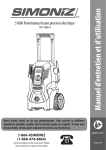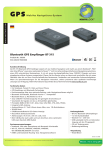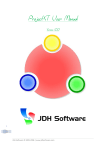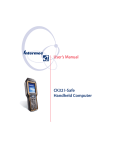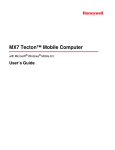Download Downloads
Transcript
ProfService Germany Newsletter 01/2008 I always get ]C1 in front of scanned barcodes .............................................................................................. 2 Search and replace inside a barcode with GRID........................................................................................... 2 GRID data editing examples ............................................................................................... 2 IP4, IVA 4.03.35.1064 and SR07022200 ..................................................................................................... 3 Autoinstall custom applications .................................................................................................................... 3 AutoRun/AutoCab on Windows Mobile 2003 devices....................................................... 3 Using \Flash File Store.................................................................................................. 3 Using a memory card .................................................................................................... 4 Windows Mobile 2005: sstransfer.xml ............................................................................... 5 Using Flash File Store................................................................................................... 5 Using a memory card .................................................................................................... 7 NEW Intermec Developer Library Resource Kits ........................................................................................ 8 How are applications launched on events ..................................................................................................... 8 1 I always get ]C1 in front of scanned barcodes You scanned an EAN128 barcode. Per default, the option 'EAN128 identifier' is enabled. Just start Intermec Settings or Configuration Utility (CK3x) and look for DataCollection-InternalScannerSymbologies-Code128-EAN128 identifier. Search and replace inside a barcode with GRID With the use of GRID data editing you can search inside a scanned barcode and change the data sent by the virtual wedge. GRID editing is not possible for application that use the scanner directly, it only works via the keyboard wedge (the barcode is scanned and transfered via the keyboard buffer into the application). GRID data editing examples Replace the two 0s at start of 00340483950005513226 by nothing: (00)(.*)=>\2; Please note, that the clear text below some barcodes will not allways show what is really in the barcode: The GRID "(00)(.*)=>\2;" will work on all barcodes as it does not check the length of strings to show. If you scan a barcode with no 00 at beginning, the scanner will not deliver it to the wedge. You will one good beep for the scanner has recognized the barcode, but then you get a bad beep as the barcode does not match the search string "(00)(.*)" If you would like to get other barcodes unchanged, you can declare an second rule. The GRID will search through the GRID line and does a search/replace for the first matching rule. The Grid: (00)(.*)=>\2;.* 2 will output barcodes starting with 00 without the 00 and all other barcodes without change (as long as there are no control characters inside. To add a line feed to the replace expression, you can use \x0D or the DataCollection-InternalScannerSymbologyOptions setting for Postamble. (00)(.*)=>\2\x=D;*\x0D If the GRID string gets longer, you can place it in a file and separate each grid with a CrLf. Lines starting with a semicolon will treated as comments. The grid file is evaluated line by line and the engine applies the first matching grid only. To use a file as grid, enter "<FILE>\Windows\grid.txt" (replace \Windows\grid.txt with the file location and name of your file. If the grid will become more complex or you will have more than 9 groups (\x syntax), you can write a DLL which does the search and replace. More Information about GRID data editing can be found in the user manual of your device and the white paper "UTILIZING GRID EDITING CAPABILITIES OF INTERMEC DEVICES". The GRID syntax is similar to the Unix grep commend. To examine grep like RegEx expressions, you can use the free PC software "The RegEx Coach". IP4, IVA 4.03.35.1064 and SR07022200 Actually the above SR will possible disturb the functionality of the IP4 if used together with BETA RFID IVA 4.03.35.1064. See KC bulletin answer #10122 for details. Autoinstall custom applications AutoRun/AutoCab on Windows Mobile 2003 devices Using \Flash File Store If the cab files to install are not to big, you can directly place them on the device in the folder \Flash File Store\Cabfiles. Ensure the cab files are marked read-only, otherwise they are deleted after install. If the device is cold booted, the cab files will be installed after the intermec cab files are installed and the device does a warmboot. To have the cab files being installed in a specific order (ie first the 3 compact framework 2 and then the application), you have to place an ASCII file in the folder \Flash File Store\2577 and name it AutoCab.dat. The file should have a line for each cab to install. Enter the names of the cab files without a path. Example Cabfiles to install are DC_Net.CAB, LagerInventur.CAB, NETCFv2.cab, sqlce30.CAB, sqlce30.dev.CAB and sqlce30.repl.CAB. To have them install in the right order, create the following AutoCab.dat file and place it at \Flash File Store\2577 on the device: NETCFv2.cab sqlce30.CAB sqlce30.dev.CAB sqlce30.repl.CAB DC_Net.CAB LagerInventur.cab Note: Do not use longer names for the cabfiles or the cabfiles install will behave very strange. The original names of the SQL CE 3.0 files are to long: sqlce30.dev.ENU.ppc.wce4.armv4.CAB sqlce30.ppc.wce4.armv4.CAB sqlce30.repl.ppc.wce4.armv4.CAB Now place all the files listed in AutoCab.dat in the folder \Flash File Store\Cabfiles. If there more cabfiles in this folder, first the listed files are installed and then the not listed. If a listed cab files is not available, you will get an error message during OS startup. Automatic warmboot after install To let the device do a warmboot after the install of these custom cabs, let one of the cabs install a file called __resetmeplease__.txt into the windows dir. If autocab encounters this file, it will do a reboot after this group of cabfiles has been installed. Using a memory card If there are more files to install or to autoinstall devices without first changing the device's file system, you can use a memory card. Create a directory 2577 and one called Cabfiles on the memory card. The name of the inserted memory card at the device maybe "Storage Card" or "SDMMC Disk". I will use "Storage Card" in further writing. OK, you have now two dirs on your card. Now copy AutoCab.exe, AutoCab.dat, AutoRun.exe and AutoRun.dat from the device's \Flash File Store\2577 directory. Then copy the cab files to install into the directory \CabFiles on the card. Ensure, they are marked read-only or they will be deleted after first install. Storage Card + 2577 - AutoCab.exe | AutoCab.dat | AutoRun.exe | AutoRun.dat | + Cabfiles - NETCFv2.cab sqlce30.CAB sqlce30.dev.CAB sqlce30.repl.CAB DC_Net.CAB LagerInventur.cab 4 You have to change the AutoRun.dat now, so it uses the memory card. Your original file Storage Card\2577\AutoRun.dat should look like this: EXEC "Flash File Store\2577\AutoCab.exe" -CHKRST=1 -SHOW=1 CALL "Flash File Store\2577\AutoUser.dat" Change this now to: EXEC "Storage Card\2577\AutoCab.exe" -CHKRST=1 -SHOW=1 You can change the file on the memory card inserted in a card reader at your desktop pc. With the files in place, you can now insert the card into a WM2003 device and do a cold boot. The device will then boot, install the intermec files, warmboot and install your custom files. Windows Mobile 2005: sstransfer.xml Unfortunately the AutoRun on the WM2005 devices will actually not chain from the internal memory to external memory cards. So, a WM2005 device will only execute the first AutoRun it finds. To get a device, that autoinstalls everything needed, you can extend the \Flash File Store\SSPB folder and change the file _sstransferagent.xml. If storage memory gets low, you have to switch to external storage and insert a memory card. As only one _sstransferagent.xml is run on startup, you have to put the intermec files and your custom files onto the memory card. Using Flash File Store A CN3 will have following files in Flash File Store\SSPB after installation of the SSPB: _sstransferagent.xml CN3_WM5_SSPB_ID.CAB IBI.cab idl.CAB iGPSApplet.cab InstallSelectCN3WM.CAB Intermec_DHCP.cab IntermecValueAdd.js IntermecValueAdd.txt itcauto.CAB itcivacn3wm.cab OtherNeededStuff.WM2005_ARMVI.CAB PowerPro.CAB PrinterSupport.CAB SetupASTStart.itc supprcmagneto.cab wlenablercn3.arm.cab The file _sstransferagent.xml controls which files will be installed at a clean boot and what applications will run on startup. <?xml version="1.0"?> <Devices> <Device Type="C" Family="N" Model="3"> <Files SrcDir="\Flash File Store\SSPB"> <!-- files to load to the device --> <File SrcName="SetupASTStart.itc" DestName="SetupASTStart.itc" DestDir="\Windows" ConfigString="CN3*" OS="PocketPC"/> 5 <File SrcName="InstallSelectCN3WM.CAB" DestName="InstallSelectCN3WM.CAB" DestDir="\CabFiles" ConfigString="CN3*" OS="PocketPC"/> <File SrcName="itcivacn3wm.CAB" DestName="itcivacn3wm.CAB" DestDir="\CabFiles" ConfigString="CN3*" OS="PocketPC" Desc="Data Collection & Intermec Settings"/> <File SrcName="SuppRCMagneto.CAB" DestName="SuppRCMagneto.CAB" DestDir="\CabFiles" ConfigString="CN3*" OS="PocketPC" Desc="Funk Wireless Security"/> <File SrcName="IntermecValueAdd.txt" DestName="IntermecValueAdd.txt" DestDir="\Windows" ConfigString="CN3*" OS="PocketPC"/> <File SrcName="IntermecValueAdd.js" DestName="IntermecValueAdd.js" DestDir="\Windows" ConfigString="CN3*" OS="PocketPC"/> <File SrcName="PrinterSupport.CAB" DestName="PrinterSupport.CAB" DestDir="\CabFiles" ConfigString="CN3*" OS="PocketPC" Desc="Printer Support"/> <File SrcName="WLEnablerCN3.ARM.CAB" DestName="WLEnablerCN3.ARM.CAB" DestDir="\CabFiles" ConfigString="CN3????????E1??" OS="PocketPC" Desc="Avalanche Enabler"/> <File SrcName="WLEnablerCN3.ARM.CAB" DestName="WLEnablerCN3.ARM.CAB" DestDir="\CabFiles" ConfigString="XCN3????????E2??" OS="PocketPC" Desc="Avalanche Enabler"/> <File SrcName="WLEnablerCN3.ARM.CAB" DestName="WLEnablerCN3.ARM.CAB" DestDir="\CabFiles" ConfigString="XCN3????????E3??" OS="PocketPC" Desc="Avalanche Enabler"/> <File SrcName="Intermec_DHCP.cab" DestName="Intermec_DHCP.cab" DestDir="\CabFiles" ConfigString="CN3*" OS="PocketPC" Desc="Intermec DHCP Client"/> <File SrcName="itcauto.CAB" DestName="itcauto.CAB" DestDir="\Temp" ConfigString="CN3*" OS="PocketPC"/> <File SrcName="IBI.cab" DestName="IBI.cab" DestDir="\CabFiles" ConfigString="CN3*" OS="PocketPC" Desc="Bluetooth"/> <File SrcName="CN3_WM5_SSPB_ID.CAB" DestName="CN3_WM5_SSPB_ID.CAB" DestDir="\CabFiles" ConfigString="CN3*" OS="PocketPC" /> <File SrcName="idl.CAB" DestName="idl.CAB" DestDir="\CabFiles" ConfigString="CN3*" OS="PocketPC" Desc="IDLRuntime"/> <File SrcName="PowerPro.CAB" DestName="PowerPro.CAB" DestDir="\CabFiles" ConfigString="CN3*" OS="PocketPC" Desc="Power Profiler"/> <File SrcName="iGPSApplet.cab" DestName="iGPSApplet.cab" DestDir="\CabFiles" ConfigString="CN3*" OS="PocketPC" Desc="GPS Applet"/> <File SrcName="OtherNeededStuff.WM2005_ARMVI.CAB" DestName="OtherNeededStuff.WM2005_ARMVI.CAB" DestDir="\CabFiles" ConfigString="CN3*" OS="PocketPC" Desc="Additional Files"/> <File SrcName="" DestName="wceload.exe" DestDir="\windows" ConfigString="CN3*" Run="true" CmdLine=" /noui \Temp\itcauto.CAB" StartIn="\"/> <File SrcName="" DestName="RunAutoRun.exe" DestDir="\Windows" ConfigString="CN3*" Run="NoWait" CmdLine="" StartIn="\"/> </Files> </Device> </Devices> You see many lines that initiate a copy of a cab file to \Cabfiles or other destinations. Then the itcauto.cab is installed by running wceload.exe. Finally RunAutoRun is executed, which will start the install of the cabfiles copied to \Cabfiles. To have your cabfiles also installed automatically, you have to copy the cabfiles to Flash File Store\SSPB and then insert lines in Flash File Store\SSPB\_sstransferagent.xml. Insert a new line for every custom cabfile to install. Use the syntax used for the intermec cabfiles. For example, to get a file MachineConfig.cab installed automatically, please a copy of the file at \Flash File Store\SSPB and insert following line before the line with the RunAutoRun.exe command: <File SrcName="MachineConfig.CAB" DestName="MachineConfig.CAB" DestDir="\CabFiles" ConfigString="CN3*" OS="PocketPC" Desc="Config"/> 6 Now, when you do a clean boot, your MacineConfig.cab is installed automatically at the end of the intermec install. The cabfiles are installed in the order they are copied to \Cabfiles. Using a memory card If you dont like to setup a device with several (manual) steps or if you need more storage on the device or if your custom cab files are too large you can put the SSPB and custom files on a memory card. Then change the \_sstransferagent.xml file on the memory card to avoid the normal SSPB install. The normal install will copy all SSPB files to \Flash File Store\SSPB and then change the _sstransferagent.xml location in the registry of the device: <?xml version="1.0"?> <Devices> <Device Type="C" Family="N" Model="3"> <Commands> <Chain Dir="\Flash File Store\SSPB" /> <DeleteDir Dir="\Flash File Store\SSPB" /> <CopyDir SrcDir="\SD CARD\SSPB" DestDir="\Flash File Store\SSPB"/> <SetRegKey KeyName="Software\Intermec\Devmgmt\SSTransferAgent" ValueName="PostBootFileLocation" Value="\Flash File Store\SSPB" /> </Commands> </Device> </Devices> You must change this file, so the device always uses the memory card as source for _sstransferagent.xml: <?xml version="1.0"?> <Devices> <Device Type="C" Family="N" Model="3"> <Commands> <Chain Dir="\SD Card\SSPB" /> <SetRegKey KeyName="Software\Intermec\Devmgmt\SSTransferAgent" ValueName="PostBootFileLocation" Value="\SD Card\SSPB" /> </Commands> </Device> </Devices> The SSPB directory on the memory card should have the following files plus your custom cabfiles: _SSTransferAgent.xml CN3_WM5_SSPB_ID.CAB IBI.CAB idl.CAB iGPSApplet.cab InstallSelectCN3WM.CAB Intermec_DHCP.cab IntermecValueAdd.js IntermecValueAdd.txt itcauto.CAB itcivacn3wm.cab OtherNeededStuff.WM2005_ARMVI.CAB PowerPro.CAB PrinterSupport.CAB SetupASTStart.itc supprcmagneto.cab wlenablercn3.arm.cab When all files are changed and in place, perform a clean boot and your device will automatically install the SSPB contnents and your custom cabfiles. 7 NEW Intermec Developer Library Resource Kits On 12. december 2007 the following resource kits have been updated: IDL Resource Kit - Data Collection ver. 3.20 IDL Resource Kit - Device Management ver. 3.10 IDL Resource Kit Antares Migration ver. 3.10 On 14. december 2007 the following kits have been updated: IDL Resource Kit - Communications ver. 3.10 IDL Resource Kit - Bluetooth ver. 3.10 IDL Resource Kit - Mobile Gadgets ver. 3.10 IDL Resource Kit Printing ver. 3.10 Keep up to date and periodically look at http://home.intermec.com/eprise/main/GSS/Service/Content/Downloads/Show_DownloadSearchResults? Product=DEVRESOURCEKIT Installation Problems? As I tried to update all these resource kits on my german WinXP, the installer stopped for erratic things. First it says, it has to remove the old version. OK, I thought this is no problem and I selected Yes, uninstall the previous version. But then it stops and said, it could not find the file "...\Windows\Installer\Intermec Data Collection Resource Kit.msi" ( as I tried to install the DC resource kit). The installer reversed all changes and finished without installing the new version. Now, I tried to remove the old DC res. kit by using control panel-add/remove software. But this stopped with the same error for the missing file. I then started the new installer again and looked at my temp folder. In one of the actual subdirs I found the missing file and copied it to \Windows\Installer. Now, I was able to uninstall the older resource kit using Settings-add/remove software without any problems. I tried again to install the new resource kit, but it still states, it has found an old version. I deleted the directory with the old version, same complain. Then I looked at the registry of my PC and found HKLM\Software\Intermec\IDL\ResourceKits. There the old resource kit was still listed - what an uninstall. OK, I deleted the two keys found for the datacollection resource kit (DCPC and DCRK) and NOW I was able to install the new datacollection resource kit. Same procedure had to be done on my PC with others of the 'new' resource kits. How are applications launched on events Do you wonder, how ActiveSync is launched automatically, when you dock a Windows Mobile device? Or would you like to launch your own application at special events? Then take a look at the notification API (CeGetUserNotificationHandles, CeGetUserNotification, .NET: State and Notification Broker API). I already done a small app called iRunAtEvent, which enables you to take a look at events and assigned applications. It does not have a GUI, it just creates a text file in the root of the device, where you can check the function. Here is the printout of a simple "iRunAtEvent list list" command of a CN3: ================================ iRunAtEvent started ========================================== 01.06.2005 23:19:00: options =========== set fullPathExeName event will set app to run at event sample: iRunAtEvent set "\Windows\pword.exe" NETCONNECT 8 reset fullPathExeName will reset all events set for app sample: iRunAtEvent reset "\Windows\pword.exe" list will dump a list of apps linked to eventssample: iRunAtEvent list ================================ known events: TIMECHANGE SYNCEND ONACPOWER OFFACPOWER NETCONNECT NETDISCONNECT DEVICECHANGE IRDISCOVERED RS232DETECTED RESTOREEND WAKEUP TZCHANGE MACHINENAMECHANGE ================================ Unsupported Events: IRDISCOVERED NETCONNECT NETDISCONNECT OFFACPOWER ONACPOWER ================================ \iRunAtEvent.exe list list ========== notification registered apps ================ Handle Status AppName Event Type 0x3300000e 0x0 \Windows\calupd.exe NOTIFICATION_EVENT_NONE 0x3100000f 0x0 CALNOT.EXE NOTIFICATION_EVENT_NONE 0x31000010 0x0 clocknot.exe NOTIFICATION_EVENT_NONE 0x3200000c 0x0 \windows\rtcupdate.exe NOTIFICATION_EVENT_TIME_CHANGE 0x30000008 0x0 calnot.exe NOTIFICATION_EVENT_RESTORE_END 0x30000009 0x0 calnot.exe NOTIFICATION_EVENT_TIME_CHANGE 0x30000007 0x0 clocknot.exe NOTIFICATION_EVENT_TIME_CHANGE 0x30000006 0x0 clocknot.exe NOTIFICATION_EVENT_RESTORE_END 0x3200000d 0x0 Program Files\Intermec\Network\Bluetooth\btcc.exe NOTIFICATION_EVENT_WAKEUP 0x30000004 0x0 repllog.exe NOTIFICATION_EVENT_LAST 0x30000005 0x0 repllog.exe NOTIFICATION_EVENT_TIME_CHANGE 0x30000003 0x0 repllog.exe NOTIFICATION_EVENT_RS232_DETECTED At the bottom of the file you will find the registered applications. Although the CN3 has an USB dock, you will see, that ActiveSync (repllog.exe) is launched by an event called NOTIFICATION_EVENT_RS232_DETECTED. To have your own application also start as soon as a dock connection is recognized, you can use the command iRunAtEvent set \Path\MyApp.exe TIMECHANGE (replace \Path and \MyApp.exe with the names of your choice). With this in place, your app will be started with every docking detected. You can also remove an application from the list. In example, if you dont like ActiveSync is started automatically on docking, then use the command: iRunAtEvent reset repllog.exe This will remove all repllog.exe entries from the notification list. 9










